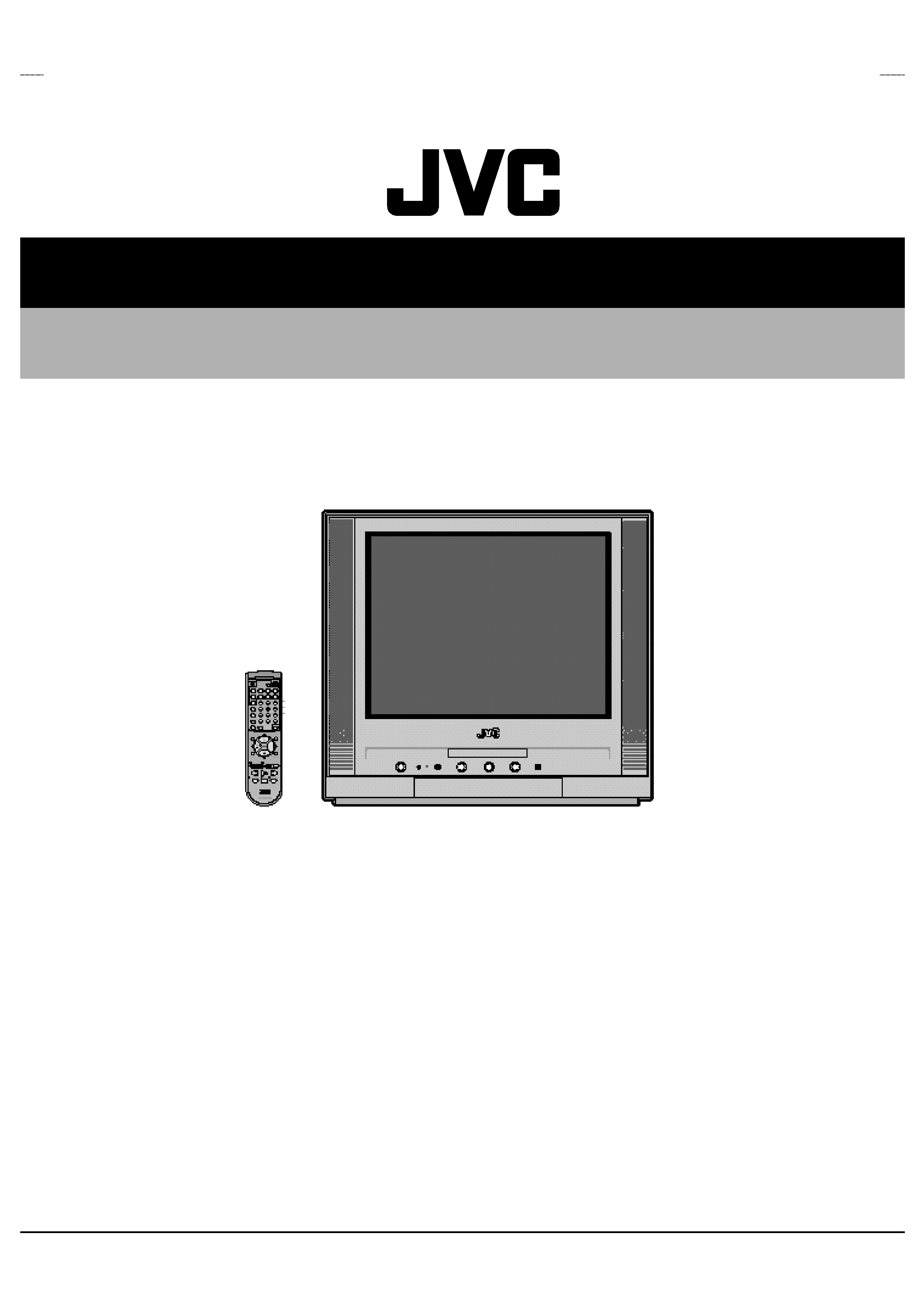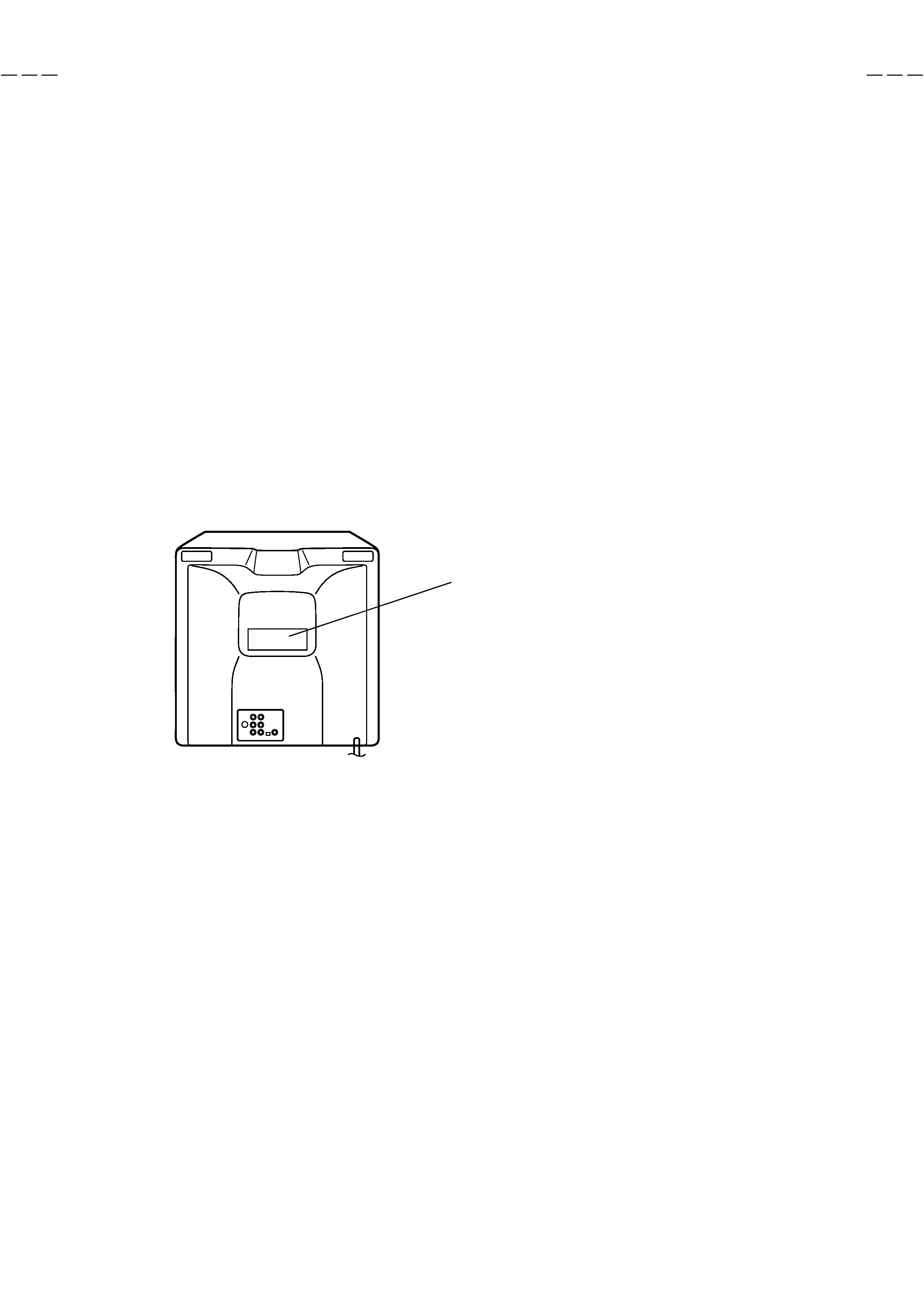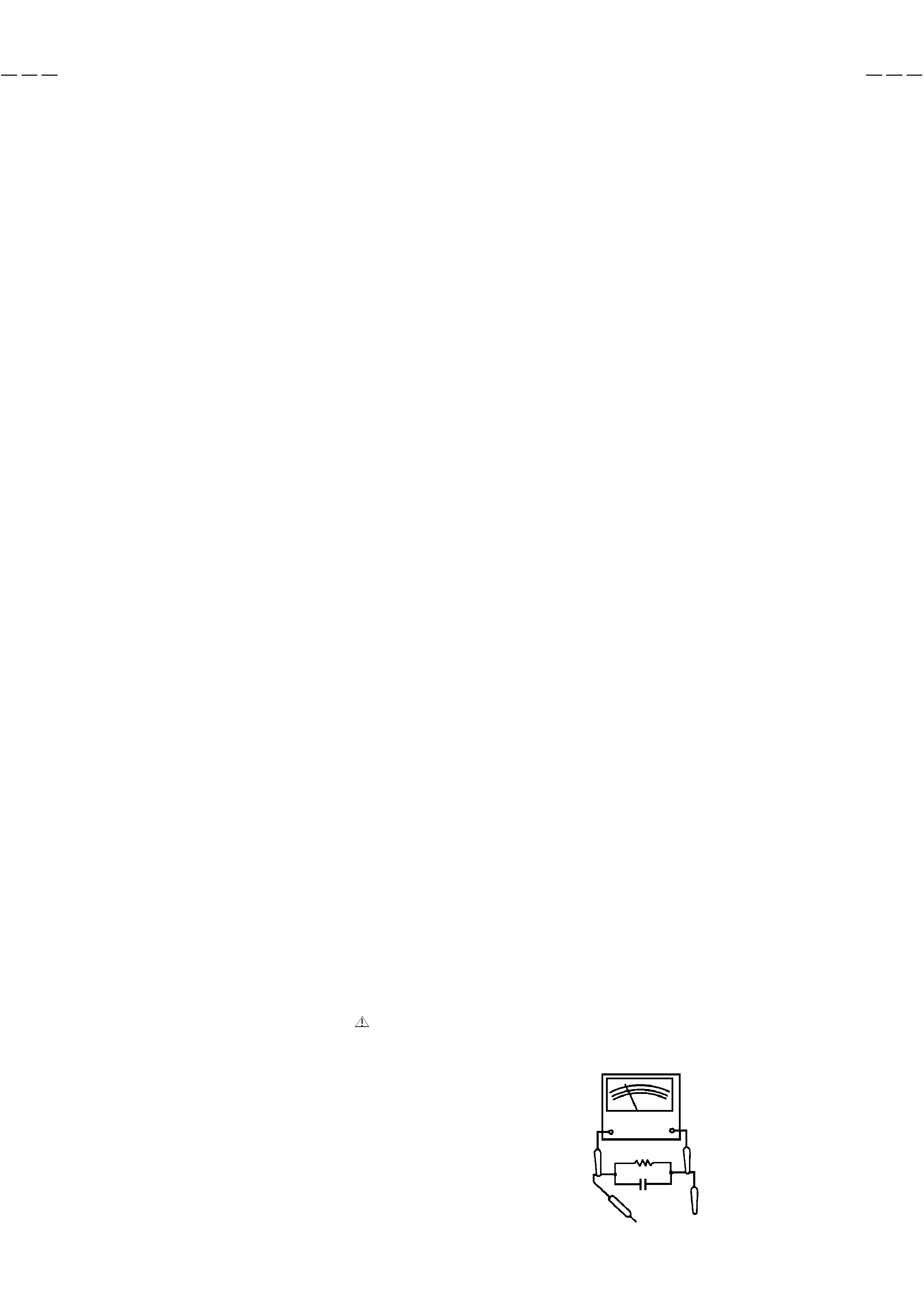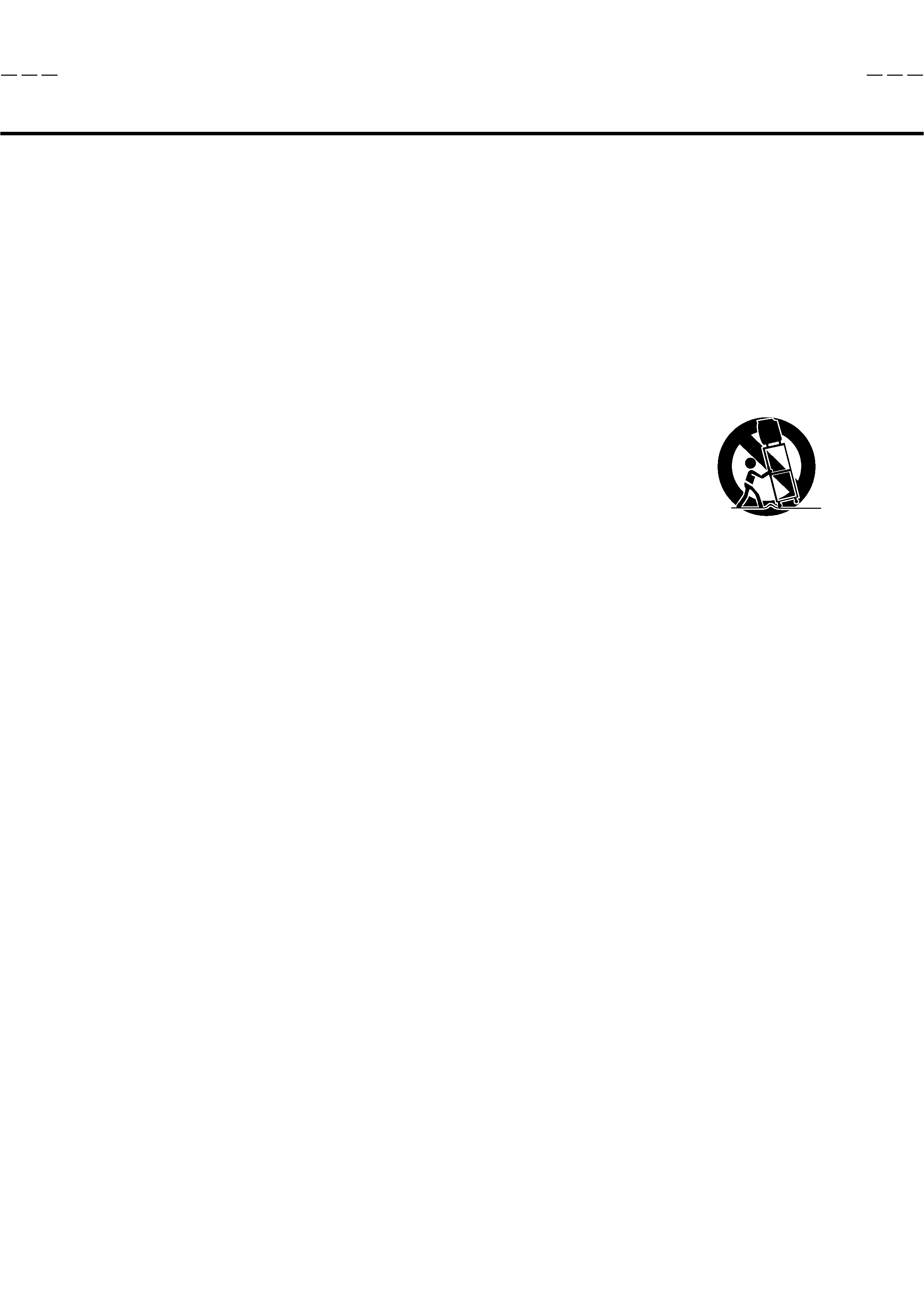
No. 51821
Mar. 2001
AV-20FD22
COPYRIGHT © 2001 VICTOR COMPANY OF JAPAN, LTD.
AV-20FD22
CONTENTS
SPECIFICATIONS
2
OPERATING INSTRUCTIONS (APPENDED)
SAFETY PRECAUTIONS
3
SPECIFIC SERVICE INSTRUCTIONS
7
SERVICE ADJUSTMENTS
13
GUIDE FOR REPAIRING
18
STANDARD CIRCUIT DIAGRAM (APPENDED)
PARTS LIST
32
SERVICE MANUAL
TV/DVD COMBO

2
AV-20FD22
SPECIFICATIONS
GENERAL
Power supply:
AC 120V 60Hz
Power consumption:
Operation: 120W
Stand by: 8W
Weight:
56.1lbs (25.5 kg)
Dimensions:
Width : 22-5/8 inches (574 mm)
Height: 20-3/8 inches (515 mm)
Depth : 19-1/8 inches (483 mm)
TELEVISION
Picture tube:
Type 20 (508 mm diagonal)
Tuner type:
Quartz PLL Frequency Synthesized
Receiving channels:
VHF 2-13
UHF 14-69
CATV
14-36 (A)-(W)
37-59 (AA)-(WW)
60-85 (AAA)-(ZZZ)
86-94 (86)-(94)
95-99 (A-5)-(A-1)
100-125 (100)-(125)
01 (5A)
Antenna input:
VHF/UHF In 75 ohm coaxial
Speaker:
3" (76 mm), 8 ohm x 2
Audio output power:
2.5W + 2.5W
DVD/CD player
Signal system:
NTSC
Applicable disc:
1. DVD (12cm, 8cm)
2. CD (12cm, 8cm)
Audio characteristics:
DVD: 4Hz - 22KHz
Frequency response:
CD: 4Hz - 20KHz
S/N Ratio:
90dB
Harmonic distortion:
0.01%
Wow and flutter:
Below Measurable Level
Dynamic range:
96dB
Input/Output:
Inputs :
Video : (RCA) 1 Vp-p/75ohm
Audio : (RCA) 8 dB/50Kohm
Outputs : Video : (RCA) 1 Vp-p/75ohm
Audio : (RCA) 8 dB/1Kohm
Headphone Jack:
3.5mm Stereo mini-jack
Digital audio out:
0.5Vp-p 75ohms terminated
Pickup:
CD :
Wavelength: 775 - 815 nm
Maximum output power: 0.5 mW
DVD :
Wavelength: 650 - 666 nm
Maximum output power: 2.0 mW
Accessories:
Remote control x 1
Batteries (2 x AA)
Design & specification are subject to change without notice.

3
AV-20FD22
CAUTION
THIS DIGITAL VIDEO PLAYER EMPLOYS A LASER SYSTEM.
TO ENSURE PROPER USE OF THIS PRODUCT, PLEASE READ THIS SERVICE MANUAL CARE-
FULLY AND RETAIN FOR FUTURE REFERENCE. SHOULD THE UNIT REQUIRE MAINTENANCE,
CONTACT AN AUTHORIZED SERVICE LOCATION-SEE SERVICE PROCEDURE.
USE OF CONTROLS, ADJUSTMENTS OR THE PERFORMANCE OF PROCEDURES OTHER THAN
THOSE SPECIFIED HEREIN MAY RESULT IN HAZARDOUS RADIATION EXPOSURE.
TO PREVENT DIRECT EXPOSURE TO LASER BEAM, DO NOT TRY TO OPEN THE ENCLOSURE.
VISIBLE LASER RADIATION MAY BE PRESENT WHEN THE ENCLOSURE IS OPENED. DO NOT
STARE INTO BEAM.
Location of the required Marking
The rating sheet and the safety caution are on the rear of the unit.
CERTIFICATION: COMPLIES WITH FDA
RADIATION PERFORMANCE STANDARDS,
21 CFR SUBCHAPTER J.
SAFTY PRECAUITONS

4
AV-20FD22
IMPORTANT SERVICE SAFETY INFORMATION
Operating the receiver outside of its cabinet or with its
back removed involves a shock hazard. Work on these
models should only be performed by those who are
thoroughly familiar with precautions necessary when
working on high voltage equipment.
Exercise care when servicing this chassis with power
applied. Many B plus and high voltage RF terminals are
exposed which, if carelessly contacted, can cause
serious shock or result in damage to the chassis.
Maintain interconnecting ground lead connections
between chassis, escutcheon, picture tube dag and
tuner cluster when operating the chassis.
These receivers have a "polarized" AC line cord. The
AC plug is designed to fit into standard AC outlets in one
direction only. The wide blade connects to the "ground
side" and the narrow blade connects to the "hot side" of
the AC line. This assures that the TV receiver is properly
grounded to the house wiring. If an extension cord must
be used, make sure it is of the "polarized" type.
Since the chassis of this receiver is connected to one
side of the AC supply during operation, service should
not be attempted by anyone not familiar with the
precautions necessary when working on these types of
equipment.
When it is necessary to make measurements or tests
with AC power applied to the receiver chassis, an
Isolation Transformer must be used as a safety
precaution and to prevent possible damage to
transistors. The Isolation Transformer should be
connected between the TV line cord plug and the AC
power outlet.
Certain HV failures can increase X-ray radiation.
Receivers should not be operated with HV levels
exceeding the specified rating for their chassis type. The
maximum operating HV specified for the chassis used in
these receivers is 32kV
±1.0kV at zero beam current with
a line voltage of 120V AC. Higher voltage may also
increase the possibility of failure in the HV supply.
It is important to maintain specified values of all
components in the horizontal and high voltage circuits
and anywhere else in the receiver that could cause a
rise in high voltage, or operating supply voltages. No
changes should be made to the original design of the
receiver.
Components shown in the shaded areas on the
schematic diagram and/or identified by
in the
replacement parts list should be replaced only with exact
factory recommended replacement parts. The use of
unauthorized substitute parts may create shock, fire, X-
ray radiation, or other hazards.
To determine the presence of high voltage, use an
accurate high impedance HV meter connected between
the second anode lead and the CRT dag grounding
device. When servicing the High Voltage System,
remove static charges from it by connecting a 10k ohm
resistor in series with an insulated wire (such as a test
probe) between the picture tube dag and 2nd anode
lead (have AC line cord disconnected from AC supply).
The picture tube used in this receiver employs integral
implosion protection. Replace with a tube of the same
type number for continued safety. Do not lift picture tube
by the neck. Handle the picture tube only when wearing
shatterproof goggles and after discharging the high
voltage completely. Keep others without shatterproof
goggles away.
When removing springs or spring mounted parts from
the tuner, tuner cluster or chassis, shatterproof goggles
must be worn. Keep others without shatterproof goggles
away.
Before returning the receiver to the user, perform the
following safety checks:
1.
2.
3.
Plug the AC line cord directly into a 120V AC receptacle.
(Do not use an Isolation Transformer during these
checks.) All checks must be repeated with the AC line
cord plug connection reversed. (If necessary, a
nonpolarized adapter plug must be used only for the
purpose of completing these checks.)
If available, measure current using an accurate leakage
current tester. Any reading of 0.35mA or more is
excessive and indicates a potential shock hazard which
must be corrected before returning the receiver to the
owner.
If a reliable leakage current tester is not available, this
alternate method of measurement should be used.
Using two clip leads, connect a 1500 ohm, 10 watt
resistor paralleled by a 0.15
µF capacitor in series with a
known earth ground, such as a water pipe or conduit
and the metal part to be checked. Use a VTVM or VOM
with 1000 ohms per volt, or higher, sensitivity to
measure this AC voltage drop across the resistor. Any
reading of 0.35 volt RMS or more is excessive and
indicates a potential shock hazard which must be
corrected before returning the receiver to the owner.
Inspect all lead dress to make certain that leads are
not pinched or that hardware is not lodged between
the chassis and other metal parts in the receiver.
Replace all protective devices such as nonmetallic
control knobs, insulating fishpapers, cabinet backs,
adjustment and compartment covers or shields,
isolation resistor-capacitor networks, mechanical
insulators, etc.
To be sure that no shock hazard exists, a check for
the presence of leakage current should be made at
each exposed metal part having a return path to the
chassis (antenna, cabinet metal, screw heads, knobs
and/or shafts, escutcheon, etc.) in the following
manner.
TO KNOWN
EARTH GROUND
AC SCALE
VT VM
1.5K OHMS
10W
15
µF
TEST PROBE
TO EXPOSED
METAL PARTS

5
AV-20FD22
IMPORTANT SAFEGUARDS
1.
2.
3.
4.
5.
6.
7.
8.
8A.
9.
10.
11.
12.
13.
14.
15.
16.
17.
18.
READ INSTRUCTIONS
All the safety and operating instructions should be read before the unit is operated.
RETAIN INSTRUCTIONS
The safety and operating instructions should be retained for future reference.
HEED WARNINGS
All warnings on the unit and in the operating instructions should be adhered to.
FOLLOW INSTRUCTIONS
All operating and use instructions should be followed.
CLEANING
Unplug this unit from the wall outlet before cleaning. Do not use liquid cleaners or aerosol cleaners. Use a damp cloth for cleaning.
ATTACHMENTS
Do not use attachments not recommended by the unit's manufacturer as they may cause hazards.
WATER AND MOISTURE
Do not use this unit near water. For example, near a bathtub, washbowl, kitchen sink, or laundry tub, in a wet basement, or near a
swimming pool.
ACCESSORIES
Do not place this unit on an unstable cart, stand, tripod, bracket, or table. The unit may fall,
causing serious injury, and serious damage to the unit. Use only with a cart, stand, tripod,
bracket, or table recommended by the manufacturer.
An appliance and cart combination should be moved with care. Quick stops, excessive force,
and uneven surfaces may cause the appliance and cart combination to overturn.
VENTILATION
Slots and openings in the cabinet and in the back or bottom are provided for ventilation, to ensure reliable operation of the unit, and
to protect it from overheating. These openings must not be blocked or covered. The openings should never be blocked by placing
the unit on a bed, sofa, rug, or other similar surface. This unit should never be placed near or over a radiator or heat source. This
unit should not be placed in a built-in installation such as a bookcase or rack unless proper ventilation is provided or the manufac-
turer's instructions have been adhered to.
POWER SOURCES
This unit should be operated only from the type of power source indicated on the rating plate. If you are not sure of the type of
power supply to your home, consult your appliance dealer or local power company. For units intended to operate from battery
power, or other sources, refer to the operating instructions.
GROUNDING OR POLARIZATION
This unit is equipped with a polarized alternating-current line plug (a plug having one blade wider than the other). This plug will fit
into the power outlet only one way. This is a safety feature. If you are unable to insert the plug fully into the outlet, try reversing the
plug. If the plug should still fail to fit, contact your electrician to replace your obsolete outlet. Do not defeat the safety purpose of the
polarized plug. If your unit is equipped with a 3-wire grounding-type plug, a plug having a third (grounding) pin, this plug will only fit
into a grounding-type power outlet. This too, is a safety feature. If you are unable to insert the plug into the outlet, contact your
electrician to replace your obsolete outlet. Do not defeat the safety purpose of the grounding-type plug.
POWER-CORD PROTECTION
Power-supply cords should be routed so that they are not likely to be walked on or pinched by items placed upon or against them,
paying particular attention to cords at plugs, convenience receptacles, and the point where they exit from the appliance.
LIGHTNING
To protect your unit from a lightning storm, or when it is left unattended and unused for long periods of time, unplug it from the wall
outlet and disconnect the antenna or cable system. This will prevent damage to the unit due to lightning and power line surges.
POWER LINES
An outside antenna system should not be located in the vicinity of overhead power lines or other electric light or power circuits, or
where it can fall into such power lines or circuits. When installing an outside antenna system, extreme care should be taken to
keep from touching such power lines or circuits, as contact with them might be fatal.
OVERLOADING
Do not overload wall outlets and extension cords, as this can result in a risk of fire or electric shock.
OBJECT AND LIQUID ENTRY
Do not push objects through any openings in this unit, as they may touch dangerous voltage points or short out parts that could
result in fire or electric shock. Never spill or spray any type of liquid into the unit.
OUTDOOR ANTENNA GROUNDING
If an outside antenna or cable system is connected to the unit, be sure the antenna or cable system is grounded so as to provide
some protection against voltage surges and built-up static charges. Section 810 of the National Electrical Code, ANSI/NFPA 70,
provides information with respect to proper grounding of the mast and supporting structure, grounding of the lead-in wire to an
antenna discharge unit, size of grounding conductors, location of antenna discharge unit, connection to grounding electrodes, and
requirements for the grounding electrode.
SERVICING
Do not attempt to service this unit yourself as opening or removing covers may expose you to dangerous voltage or other hazards.
Refer all servicing to qualified service personnel.
PORTABLE CART WARNING
(symbol provided by RETAC)
S3126A
